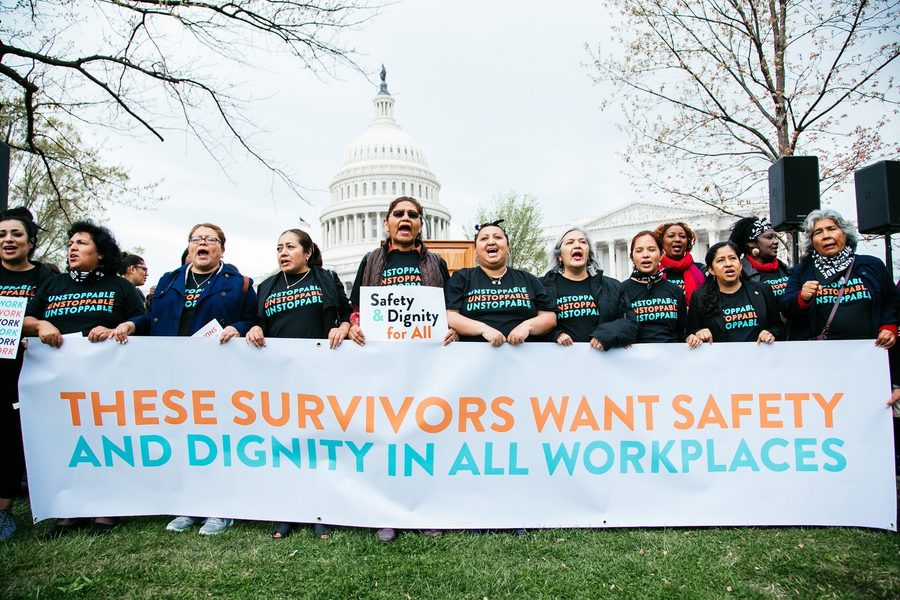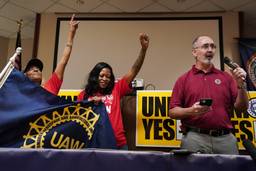
Reinvigorated movements are charting new terrain to build worker power and reverse the dramatic climate crisis facing society. Uncompromising mass mobilizations are on the rise, as more workers participated in strikes in the U.S. in 2018 than any of the previous 31 years, and historic demonstrations, like climate strikes, have taken off to demand action around climate change. Migrant workers, many of whom are climate refugees working in the care industry are waging a tremendous struggle against the Trump administration’s relentless, racist attacks, like the new “public charge” rule, which stops immigrants who receive public benefits from obtaining a green card or permanent residency. The Green New Deal offers an opportunity to bring these fights together around a broad program that tackles not only climate change, but also advances a vision of what a society that prioritizes people — not profit — could look like. But this future can only be won if the labor and climate movements find more ways to act together, and if they strategize more seriously about how to ensure low-carbon work is also good work.
The lowest carbon jobs are the ones that don’t extract anything from the land, don’t create any new waste and have a very limited impact on the environment — an idea put forward by writers and activists Naomi Klein and Astra Taylor, along with striking West Virginia teacher Emily Comer. These jobs include teaching, nurturing and caring— invaluable jobs like cleaning homes and caring for children, seniors and those living with disabilities. Care work is generally ignored or looked down upon because it doesn’t create commodities that can be bought and sold, and because it is typically done by women. The shift towards low-carbon work should necessarily include a dramatic expansion of care work. But in order to make that possible, the standards and conditions of that work must be urgently raised.
Care work is not only immensely important for individuals and families who depend on it, but for the economy at large. The National Domestic Workers Alliance (my employer) describes it as “the work that makes all other work possible.” By taking care of young children, nannies and child care workers allow parents to produce at their jobs. And by caring for seniors, home care workers, Certified Nursing Assistants and other caregivers keep those in the “sandwich generation,” caring for both children and parents, in the workforce. If there were no more caregivers — or if there were a nationwide caregiving work stoppage — our economy would crumble almost instantly.
The history of domestic work and care work, however, is stained by our country’s legacy of racism and sexism. In 1935, the National Labor Relations Act (NLRA) was passed, giving workers the legal right to organize, and recourse if they were intimidated or fired for doing so. But not all workers were afforded these rights — domestic workers and farm workers were purposefully excluded as part of a compromise in order to pass the NLRA. Democrats in the South feared that allowing farm and domestic workers to unionize would give black workers — who were the vast majority of farm workers and domestic workers — too much economic and political power.
We’ve seen how this legacy affects care work today: low pay, no benefits, and it’s often illegal to unionize. In addition to their lack of labor protections, these workers’ social standing makes them even more susceptible to abuse at work, including wage theft and sexual harassment or assault. The vast majority of domestic and care workers in this country are women of color, many of whom are migrants.
By understanding this connection, we can build deeper solidarity between care workers organizing for power on the job and the climate movement more broadly. The exclusion of domestic workers from the NLRA, and the ensuing degradation of their working conditions and lack of rights at work, was a compromise rooted in economic injustice and political exclusion — two historical wrongdoings that the Green New Deal seeks to undo.
While presidential candidates and other politicians are lauding these jobs as the key to a just transition away from fossil fuels and into a Green New Deal, we can’t expect to meaningfully transition to low-carbon work without first focusing on how to improve that work. That effort must be a central part of the transition’s strategy. Every worker deserves a union job with high wages and benefits — including domestic and care workers.
In the midst of the Great Depression and massive unemployment in the 1930s, the New Deal created nearly 10 million union jobs. We face a challenge of even larger proportions today: how to radically reconfigure our economy away from industries that poison the environment, and how to create millions of new, green union jobs.
The Green New Deal resolution put forward by Representative Alexandria Ocasio-Cortez (D-N.Y.) and Senator Ed Markey (D-Mass.) promises to do just that, stating that it will establish “high-quality union jobs” that provide a “family-sustaining wage, adequate family and medical leave, paid vacations, and retirement security.” While millions of people will be put to work repairing the damage inflicted by climate change and setting the foundation of a new economy that will help us weather the crises we couldn’t stop, millions of workers will be left to find other low-carbon work.
When we transition workers away from well-paying oil and gas jobs, we don’t just want their tacit acceptance, we want their support, participation, and excitement: It’s the only way we’ll build the political will to actually pass the Green New Deal, and transform our economy at the speed and scale necessary to halt future damage. To do this, we need a real plan to make low-carbon jobs good jobs.
The Domestic Workers Bill of Rights, which has already passed in 9 states and one city, was introduced into Congress by Representative Pramila Jayapal (D-Wash.) and Senator Kamala Harris (D-Calif.) earlier this year. The legislation will essentially amend the NLRA to include domestic workers, while also giving them some new rights too, like the right to overtime pay, safe and healthy working conditions, and written agreements with their employers. Passing the Bill of Rights is a first step in ensuring that all domestic workers are treated with respect and dignity.
In California, child care workers just won a 16-year battle for the right to unionize. Now, 12 states allow child care workers to negotiate over wages and benefits. A handful of states have recognized unions for home care worker paid through Centers for Medicare and Medicaid, although the Trump administration is now trying to make it illegal for unions to deduct dues from workers’ paychecks.
To make child care and home care jobs not just low-carbon jobs, but good jobs, every single worker in this country needs the right to collectively bargain. Without being able to stand together to bargain for wages, benefits and rights at work, workers are forced to negotiate individually — just them against the boss. For workers who are oppressed due to their race, gender or migration status, this unequal reality is compounded by the ways employers use these social systems to further erode conditions, and to undermine workers’ abilities to advocate for themselves. Collective bargaining builds power for workers to push back both against bosses who want to exploit them for their labor, and corporations that want to maximize profit through environmental destruction. Building a union and engaging in shared struggle is also our best method to build solidarity across oppression and fight our common enemy — the ultra-rich who make decisions about both our working conditions on the job and our living conditions on our planet.
Although traditional collective bargaining is possible for certain child care and home care workers — because their employer is the state — it’s more complicated for domestic workers who tend to have multiple gigs. Because nannies, private-pay home care workers and house cleaners are often isolated in individual homes, we need the government to intervene to set a wage floor for the industry, and to ensure benefits and rights for all workers.
The Albany Park Workers’ Center in Chicago experimented with a living-wage hiring hall for day laborers and domestic workers by allowing those workers to connect with employers use written contracts, and find jobs that pay a living wage. Workers were able to access a daily job distribution list, and secure jobs through a coordinator. In 2015 and 2016, workers reported an average wage of $32 per hour, which was three times Chicago’s minimum wage at the time. Experiments like this must be expanded upon at a scale that sets a wage floor for all domestic workers.
One of the biggest challenges with domestic worker rights is enforcement, because these workers are so isolated. But that’s why we need a labor movement and a climate movement that’s dedicated to prioritizing care work — both for workers’ rights and for the future of our earth. A powerful movement of working-class people is the only way we will be able to force the government to both make the economic transitions we need to save our planet, and to improve conditions for care workers. As the need for care and the need to transform our economy for the sake of our environment both continue to grow astronomically, our movements need a plan to put care workers first. And because care work intersects with so many other social struggles — sexism, racism, migration, climate justice — focusing on it expands the base in in support of a movement of workers to transform both the economy and climate.
A transition away from extractive and destructive work will necessarily mean a growth of the care industry. Organizing and raising standards for care workers needs to be a central focus of a strategy to bring labor and climate together — to envision a low carbon economy that works for all of us.







